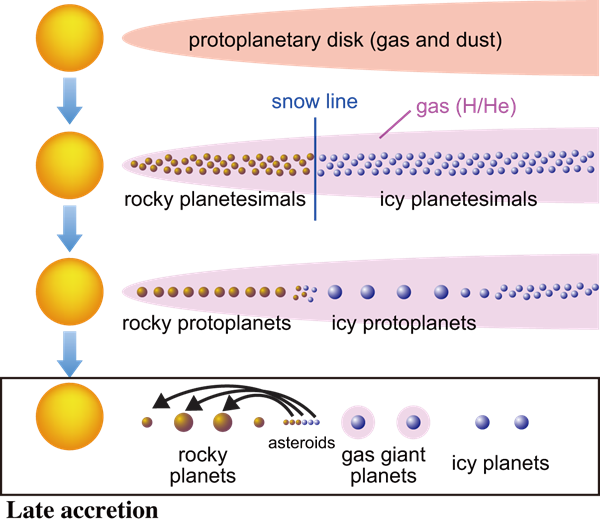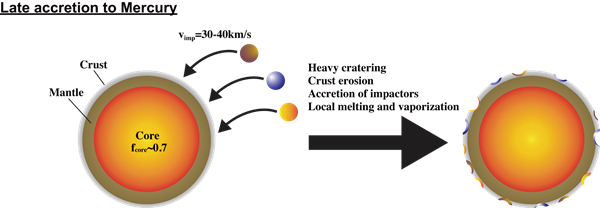Observations revealed that Mercury’s surface is rich in enigmatic volatile materials, such as a high K/Th ratio. Using Monte Carlo simulations to record cratering impacts the researchers from Earth-Life Science Institute (ELSI) at Tokyo Institute of Technology and JAXA investigated the outcomes of late accretion on Mercury. They show that only half of the impactor materials are implanted on the surface of Mercury. They conclude that late accretion is a process that could deliver exogenic materials, including the volatile-bearing materials, from a distant location to Mercury; these impacts could characterize the surface morphology and composition of Mercury. Results indicate that forthcoming surface observations of Mercury by the European Space Agency(ESA)-led BepiColombo mission will lead to a better understanding of late accretion.

In the classical planet formation theory, planets are expected to accrete at their current position, and volatile elements are thought to be depleted in the building blocks of Mercury due to its proximity to the Sun. However, previous observations suggest that Mercury’s surface is rich in volatiles. Late accretion is a process whereby leftover planetesimals, asteroids, and comets bombarded terrestrial planets after the cessation of primary accretion (at ~4.5 Ga). Late accretion to Earth is considered to be a potential mechanism that delivers water to Earth.
Researchers Ryuki Hyodo (ELSI/JAXA), Hidenori Genda (ELSI) and Ramon Brasser (ELSI) used a Monte Carlo approach to compute impacts and investigated the outcomes of late accretion on Mercury. They used the most updated results of planet formation models and impact simulations that could reproduce the results of laboratory impact experiments.
They found that late accretion could remove ~50 m to 10 km of the early crust of Mercury. Late accretion is a process that could deliver an impactor’s materials to planetary bodies, and the researchers showed that about half of an impactor’s materials are buried on the surface of Mercury as exogenic materials, which ought to include the volatile-bearing materials. Upon impact, the impactor materials are either melted or vaporized due to the very high impact velocity. This was followed by a relatively quick cooling process as late accretion is a cumulatively small impact process, and each impact only affects a local area of Mercury’s surface. The researchers concluded that late accretion is an important process that could characterize the surface morphology and composition of Mercury, including the origin of enigmatic volatiles found on Mercury’s surface.
The coverage for Mercury from previous observations, such as MESSENGER, was largely limited to the northern hemisphere, although there were important findings. The researchers expect that the further interplay between their theoretical results and the detailed surface observations of Mercury, including the BepiColombo mission, will lead us to a better understanding of Mercury’s origin and evolution.

| Journal | Icarus |
| Tile of the paper | Modification of the composition and density of Mercury from late accretion |
| Authors | Ryuki Hyodo1, Hidenori Genda2, Ramon Brasser2 |
| Affiliations |
1ISAS/JAXA, 2 Earth-Life Science Institute, Tokyo Institute of Technology |
| DOI | 10.1016/j.icarus.2020.114064 |
| Online published date | 29 August, 2020 |
